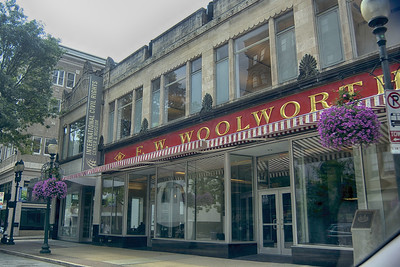See also: The Sit-In at the Greensboro Woolworth’s Store (NCpedia Student Collection)
Introduction

If there were a law or rule you thought was unfair, what would you do about it? During the civil rights movement, people organized sit-ins to protest laws they believed were unfair, like segregation laws. Segregation was the legal separation of people based on their identities, like race or religion.
Segregation in North Carolina meant keeping Black Americans and white Americans separate. Schools, swimming pools, public transportation, libraries, theatres, and more were all segregated. Black people were not allowed to use the same water fountains or bathrooms as white people. They could not shop at the same stores or sit in the same areas of restaurants. Segregation like this was legal across North Carolina and the American South for many years. Many people tried to change this in different ways, including protests.
What were the sit-ins?
People protested segregation in different ways. One of these ways was a form of protest known as a sit-in. Sit-ins were a peaceful way to protest segregation in businesses and other public places. During a sit in, protestors would “sit-in” a restaurant or other business and refuse to move. Many sit-ins happened during the civil rights movement. The civil rights movement was a time in the United States during the 1950s and 1960s when people worked together to make sure that everyone had the same rights and opportunities, no matter their race or background. People who participated in the civil rights movement wanted to end segregation and discrimination in America. They wanted Black and white people to have access to the same resources, like schools, libraries, and public transportation. People in the civil rights movement also wanted all people to be treated fairly under the law, no matter their skin color.
College students organized and led many sit-ins during the civil rights movement. They sometimes experienced violence from angry white Americans who supported segregation. The protesters expected this resistance and were trained to not fight back. They wanted the sit-in movement to be non-violent. Sit-in protests happened across North Carolina and the South, and they helped change laws across the state and country
In 1960, the sit-in movement spread across North Carolina. One sit-in in Greensboro sparked sit-in protests at lunch counters across the state, from Winston-Salem to Charlotte and all the way to Elizabeth City. Within a week of the Greensboro sit-in, sit-ins spread to other cities across the country.
Glossary:
Civil Rights Movement: A social movement in the United States during the 1950s and 1960s aimed at ending segregation and discrimination against Black Americans and ensuring equal rights for all.
Sit-in: A peaceful form of protest where people sit in a specific location, such as a restaurant or store, to challenge unfair practices.
Protest: A way of expressing strong disagreement with something, often to bring about change or raise awareness.
Segregation: The legal separation of people based on their identities, such as race or religion, which often leads to unfair treatment.
Discrimination: Unfair treatment of a person or group based on characteristics like race, age, or gender.
Read and Reflect Questions:
- What is a sit-in?
- What was the purpose of sit-in protests?
- According to the text, what were some places where people experienced segregation?
- List two North Carolina cities where sit-ins took place during the civil rights movement.